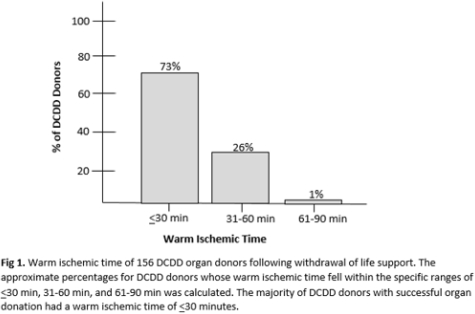Defining Ischemic Time in Lung Donation After Circulatory Determination of Cardiac Death.
1University of Maryland School of Medicine, Baltimore, MD
2Division of Cardiac Surgery, University of Maryland, Baltimore, MD.
Meeting: 2016 American Transplant Congress
Abstract number: B86
Keywords: Donors, non-heart-beating
Session Information
Session Name: Poster Session B: Donor Management: All Organs
Session Type: Poster Session
Date: Sunday, June 12, 2016
Session Time: 6:00pm-7:00pm
 Presentation Time: 6:00pm-7:00pm
Presentation Time: 6:00pm-7:00pm
Location: Halls C&D
Background: Donation after circulatory determination of death (DCDD) promises to increase the number of available lungs for transplantation. Nevertheless, the metrics to define warm ischemic time and the maximum time surgeons should wait from withdrawal of life support are still a subject of discussion. Our goal was to identify the percentage of ideal lung donors that expired after withdrawal of life support (WLS) and the time to cardiac arrest using data from our Organ Procurement Organization and United Network for Organ Sharing (UNOS).
Methods: De-identified data of DCDD donors from 2004-2013 was provided by the Living Legacy Foundation (LLF) and UNOS. Physiological data from these donors was evaluated to define variables associated to timing to arrest after WLS.
Results: 156 DCDD donors were identified. Of the 156 donors, 73% of expired within 30 minutes following WLS, 26% within 31-60 minutes, and 1% within 61-90 minutes [Figure 1]. Donors that expired within the first 30 minutes of WLS had a mean age of 35+15 years, Po2<300 (81%), a smoking history of <20 pack/years (82%), and more frequently were victims of trauma (77%).
Conclusion: Several centers have demonstrated that DCDDs provide a viable source of lungs that can contribute to reduce the lung donor gap. Nevertheless they require an extensive logistical investment. Defining variables associated with rapid demise after WLS and defining how long centers should wait after WLS will help advance DCDD use. Based on our analysis we find that 99% of the donors managed at our OPO expire within 60 minutes of WLS. In addition, young age and low oxygenation pre-WLS in the setting of trauma seemed to be associated with rapid demise. This finding has led our institution to the use of ex-vivo lung perfusion to increase the percentage of DCDDs used for lung transplantation.

CITATION INFORMATION: Pratt D, Kon Z, Iacono A, Kim J, Reed R, Timofte I, Gammie J, Pham S, Griffith B, Sanchez P. Defining Ischemic Time in Lung Donation After Circulatory Determination of Cardiac Death. Am J Transplant. 2016;16 (suppl 3).
To cite this abstract in AMA style:
Pratt D, Kon Z, Iacono A, Kim J, Reed R, Timofte I, Gammie J, Pham S, Griffith B, Sanchez P. Defining Ischemic Time in Lung Donation After Circulatory Determination of Cardiac Death. [abstract]. Am J Transplant. 2016; 16 (suppl 3). https://atcmeetingabstracts.com/abstract/defining-ischemic-time-in-lung-donation-after-circulatory-determination-of-cardiac-death/. Accessed December 28, 2025.« Back to 2016 American Transplant Congress
